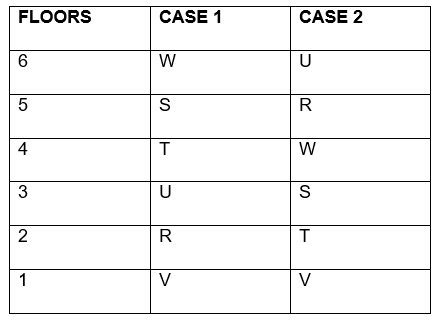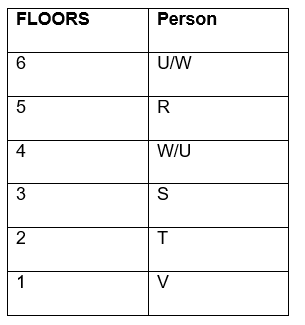Question
Six persons R, S, T, U, V and W live on each floor of a
six-storey building. The bottommost floor is numbered as 1 while the topmost floor is numbered as 6. Who lives just above V’s floor? I. W lives two floors above T’s floor. V lives on the bottommost floor. U lives just above R’s floor. II. R lives three floors above T’s floor. S lives two floors above V’s floor. V and R do not live on adjacent floors. There is at most one floor between U’s and W’s floor. The question given below consists of two statements numbered I and II given below it. You have to decide whether the data provided in the statements are sufficient to answer the question. Read all the statements and give answer.Solution
From statement I, Now, W lives two floors above T’s floor. V lives on the bottommost floor. U lives just above R’s floor. So, we have two cases,  So, either R or T is just above V’s floor. Therefore, statement I alone is not sufficient.From statement II, Now, R lives three floors above T’s floor. S lives two floors above V’s floor. V and R do not live on adjacent floors. There is at most one floor between U’s and W’s floor. So, the table is shown below,
So, either R or T is just above V’s floor. Therefore, statement I alone is not sufficient.From statement II, Now, R lives three floors above T’s floor. S lives two floors above V’s floor. V and R do not live on adjacent floors. There is at most one floor between U’s and W’s floor. So, the table is shown below,  So, T lives just above V’s floor.Therefore statement II alone is sufficient to answer the question.
So, T lives just above V’s floor.Therefore statement II alone is sufficient to answer the question.
Which of the following are not a part of liquid assets/quick assets
Consider the following statements about indifference curves:
1. Indifference curves are convex to the origin.
2. Higher indifference curve...
Delegation is considered as an important principle in management. It is a part of the _______ management function
Which of the following is the new interest rate benchmark, introduced by RBI, based on secured money markets, as a better replacement to MIBOR ?
RBI created Payments Infrastructure Development Fund (PIDF) which intends to subsidise deployment of payment acceptance infrastructure in the country. T...
A company has Rs.500,000 of debt outstanding with a coupon rate of 10%. The yield to maturity on these bonds is 15%. If the rate of tax is 40%, what is...
The new monetary Policy tool introduced by RBI this year in place of Reverse Repo was recommended earlier by which committee?
As the number of stocks in a portfolio increases, the portfolio’s systematic risk:
According to the RBI Annual Report 2023-24, what was India’s headline inflation rate for the fiscal year 2023-24?
A report on the 2021 Human Development Index (HDI) is part of the Human Development Report 2021-2022 released by the United Nations Development Program...


